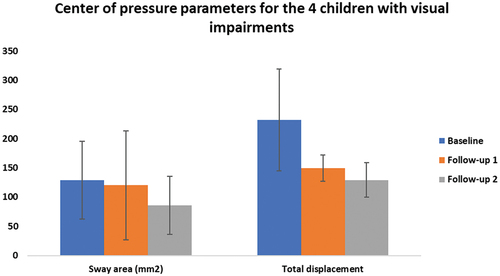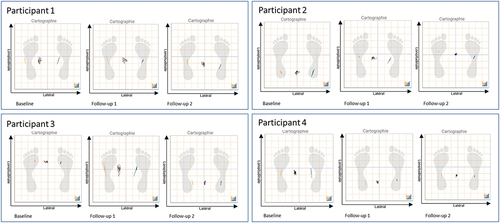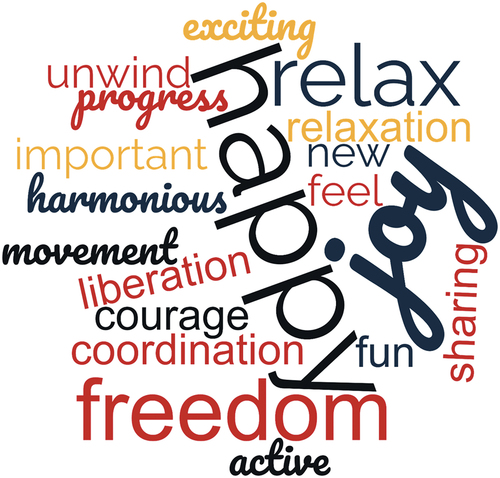ABSTRACT
Background
Children with visual impairment very often have additional motor disorders and developmental delays. They are less active than typical children of a similar age, even though physical activity is essential for their well-being.
Methods
A weekly dance class for 1 year was offered to 4 visually impaired and 5 sighted children in a conservatory.
Results
The children’s satisfaction was excellent, and they perceived an improvement in their mood, walking, balance and coordination, and felt more physically active. The walking speed, balance and posture were improved.
Conclusion
This original project, with its full integration in a dance conservatory and by mixing children with and without visual impairment, showed excellent feasibility.
Introduction
Dance is an activity that seems to be particularly suitable for people with chronic illnesses because of its physical, mental and social components (Bruyneel, Citation2019). While numerous studies have demonstrated the beneficial effects of dance on adults with neurological, cancer and rheumatological conditions, few studies have evaluated the effects of dance on children with motor and sensory disabilities, except for children with cerebral palsy (Duarte Machado et al., Citation2023). A systematic review found that dance improves their postural control, motor, cognitive, social and emotional functioning (Duarte Machado et al., Citation2023).
According to the World Health Organization (WHO), 19 million children worldwide are visually impaired, including 1.4 million who are blind. However, these figures vary widely. In Sweden, the rate of blind children is 29 per 100,000 between the aged 0–15, 60% of whom have additional impairments (e.g. mental, motor, hearing) (Blohmé & Tornqvist, Citation1997). In addition, children with early onset severe visual impairment may experience delays in motor, language, emotional, social and cognitive development (Elsman et al., Citation2021; Solebo & Rahi, Citation2014). These multiple problems have an impact on quality of life, independence and participation (Elsman et al., Citation2021).
Compared with typically developing children, children with blindness are less physically active and spend more time sedentary (Houwen et al., Citation2009), yet active behavior is essential for the well-being and the prevention of chronic diseases (Tudor-Locke et al., Citation2011). Physical activity (PA) in children with blindness has been associated with improved motor performance (Houwen et al., Citation2009) and in adults with acquired blindness, activities such as Tai Chi, yoga and dance improve functional ability and balance (Sweeting et al., Citation2020). Children with visual impairment have been characterized by deficits in postural control (Laatar et al., Citation2022), coordination (Rutkowska et al., Citation2016), running and jumping (Wagner et al., Citation2013). Dance has the advantage of using all these motor skills while stimulating the cognitive and social components (Bégel et al., Citation2022). Recently, Dubon et al. (Citation2021) suggested the importance of offering dance classes adapted to people with sensory impairment (Dubon et al., Citation2021). The only study that included people with acquired blindness showed an improvement in their functional abilities after a dance class with an 8-week follow-up (Larsson & Frändin, Citation2006).
The barriers to PA for children with disabilities are motor, communication and pain problems (Abid et al., Citation2022). In the case of visual impairment, lack of access to activities and lack of parental support for active behavior are also reported (Greguol et al., Citation2015). One of the key factors for participation in PA is motivation. However, many activities for children with disabilities take place in medical facilities and are exclusively reserved for these children, which isolates them and keeps them focused on their pathology. Given the social and participation difficulties, an inclusive class mixing blind and sighted children in a dance school should greatly facilitate the motivation and develop the inclusion of these children. To achieve this, the dance teacher needs to adapt the classes by reducing the visual support in the training and increasing the verbal instructions and tactile cues (Dubon et al., Citation2021).
Programme rationale and goals
The aim was to develop a dance course including blind and sighted children at the Conservatoire Populaire de Musique, Danse et Théâtre (Geneva). This 12-month weekly course included a choreographic project with the presentation of a show at the end of the year.
The Dance of the Senses project involved five sighted girls (aged 8 to 10) and four girls visually impaired since birth (aged 11, 12, 15 and 18, ). One participant was also partially deaf. None of the disabled participants had danced before, while the sighted girls had classical dance experience.
Table 1. Demographic data.
The dance was taught by a dance teacher and accompanied by a physiotherapist-researcher. The course was organized in the same way as all the other dance courses at the Conservatoire. The children attended one 50-minute dance class a week from late August to mid-June. An end-of-year show was planned for the June Music Festival in the Conservatoire auditorium.
In the first class, children with visual impairments discovered the space of the dance studio through touch, movement and sound. The contemporary dance class was organized around a warm-up phase, technical work, choreographic creation, improvisation and recovery. We paid special attention to the balance of the children’s roles in the dance class. The sighted children could lead the visually impaired children, but the leadership was systematically reversed in other exercises. To facilitate understanding, the dance exercises were shown, explained and then felt using tactile input. As we found that the children were reluctant to be touched, we used voice and music to guide them as much as possible.
How the programme was evaluated
As this is the first time that a dance class has been offered to visually impaired children, we implemented measurement tools in September (baseline), January (follow-up 1) and June (follow-up 2) to assess satisfaction with the classes and the effects on physical abilities. Satisfaction was assessed using a questionnaire previously used in a dance class for persons with disability (Patterson et al., Citation2018). Moreover, participants were asked to name three words to characterize the dance class and they had to answer the question “Are you satisfied with the dance class? ” with the Numeric Rating Scale-NRS/10 points. Pain, stress and fatigue were assessed with NRS before and after the dance class. 5-metre walking speed (normal and maximal), postural control (standing on stabilometric platform and the unipodal balance duration), posture (face, profile), posterior chain flexibility and quadriceps isometric strength (with dynamometer) were tested in baseline, follow-up 1 and follow-up 2.
Results
Satisfaction on the NRS scale was ≥ 9/10 (0=no satisfied and 10=completely satisfied). The majority of the words used to describe the dance were positive (). Participants also shared their experiences and stated: “when I dance, I forget all my problems”, “I was afraid of doing something wrong, but now it’s going better, I’m confident”, “we laugh all the time”, “I don’t like sports, but I love dancing”. The satisfaction questionnaire gave scores ≥ 3/5 for enjoyment of participation, the desire to continue, feelings about the contribution of dance to walking, mood, coordination, strength and being more physically active ().
Table 2. Satisfaction questionnaire results.
The sighted children had positive things to say about the dance (novelty – touch – happy – kindness – sharing – eyes – joy – fun – happy). Some of the comments were shared: “I didn’t know that you can laugh when you are blind”, “I was afraid of blind people at first, but now I feel comfortable”, “We have fun and they have fun”.
Dance classes reduced stress for all participants. Joy was always rated the highest (NRS = 10/10). Whilst post-course fatigue was lower at the baseline and follow-up 2, the follow-up 1 showed an increase in post-course physical fatigue. There was no pain during the dance classes.
Normal walking speed improved in 2 of the 4 blind participants during the year (). At maximum speed, 3 participants improved their time. It should be noted that the participant whose gait slowed down had difficulty paying attention to this test.
Table 3. Results for physical abilities for each participant with visual impairments (P1, P2, P3, P4). Bold characters represent an improvement for follow-up 1 and 2.
The balance tests showed an improvement for all blind participants at follow-up 1 and 2 ( , ).
Figure 2. Center of pressure parameters for the 4 children with visual impairments. Mean and standard deviation are represented for sway area (mm2) and total displacement (mm).

Analysis of the weight distribution between left and right foot () and the average position of the center of pressure showed a decrease in asymmetry for the follow-up 1 and 2 compared to baseline ().
Figure 3. Each figure represents the center of pressure displacement during a standing balance test during 30 seconds. For each participant, three tests are showed: baseline, follow-up 1 and follow-up 2. The closer the displacement is to center line, the more centered the participant is.

Improvements in posture were observed in the face and profile of three participants, mainly with head straightening and postural alignment.
No changes were observed in quadriceps strength or posterior chain flexibility.
End of year performance
In June at year end, the children presented a show entitled “La lumière qui est en nous” (created by Lucy Nightingale) in the Conservatoire auditorium. Rehearsals began in February. The choreography included the adult contemporary dance class. It was 25 minutes in length with a combination of dancers from different classes, but in either “main choreography” or “supporting choreography”. At the beginning of the show, one of the visually impaired dancers from the child group presented the project. Then, the blind children recited a text and went on stage alone. The show alternated between rhythmic and soft music, choreography and structured free dance. The hall was completely full (160 persons), and the audience was totally enthralled. We had many conversations with the families who shared with us the emotion they felt when they saw their children moving freely and dancing happily in such a project with people of diverse abilities and age groups. The visually impaired children participated fully and on an equal footing. We considered this a great success for this inclusion project.
Discussion
The mixed classes of visually impaired and sighted children demonstrated the feasibility of this approach and the shared benefits for all participants. Dance classes not only bring joy and reduce stress, but also improve many physical abilities, confirming the multiple social, mental and physical effects of dance for children with disabilities (Duarte Machado et al., Citation2023).
The four children with visual impairment improved their balance, posture and walking speed. Previously, the beneficial effects of dance on balance and gait were demonstrated, but for adults with acquired blindness (Larsson & Frändin, Citation2006). However, children who are blind from birth have never had the opportunity to visually represent posture in standing and dance movements, resulting in significant postural and coordination deficits and delayed motor development (Rutkowska et al., Citation2016; Wagner et al., Citation2013). This lack of visual representation of posture and movement meant that the dance teacher had to adapt the instructions. We used elastic bands and hoops to make it easier to understand the direction of movement. However, combined dance movements such as an arm and leg raise with a trunk rotation remained complicated for the participants despite obvious progress. It is often necessary to break down the movement to work on each stage. Despite the greater difficulties experienced by children born with a visual impairment, dance as PA seems to reduce their motor difficulties (Houwen et al., Citation2009). It is therefore essential to combat the sedentary lifestyle of these children and to offer them new opportunities to improve their participation and quality of life (Elsman et al., Citation2021).
Motivation and the ability to perceive beneficial effects are considered to be two important aspects of long-term engagement with PA (Tudor-Locke et al., Citation2011). Dance has the advantage of being motivating because of the group interaction and the end-of-year performance project. Moreover, mixing visually impaired and sighted children at the conservatory means that the activity is not pathology-focused. As a result, the participants told us that they forgot about their problems during the dance and that their satisfaction and enjoyment were excellent. Greguol et al. have highlighted the importance of parental support in the PA of visually impaired children (Greguol et al., Citation2015). We observed that the children’s self-fulfilment and motivation strengthened the parents’ desire to get involved in this project. Many PAs are rather discouraging and don’t give a good self-perception of the benefits. The satisfaction questionnaire which showed that the participants’ self-perception of the benefits was very good.
Future plans for creative activity
Visual impairment is often a factor that excludes young people from participating in PA interventions (Sweeting et al., Citation2020). It is therefore important to ensure that the principle of inclusion is applied. This project supports the idea that full inclusion in the conservatory, outside medical institutions, is feasible and beneficial for all participants. The sighted children were apprehensive at the beginning of the year about the disability of the blind children, but they developed skills in understanding, sharing, and creating together. As the sessions progressed, they also realized that these classes were giving them other skills in dance, such as developing a more fulfilling dance based on sensuality and sharing. The visually impaired children expressed fear of doing something wrong at first and were quite worry. They learned to lead, to take the initiative in the dance and to trust. They made great progress in a number of physical areas. By the end of the year the class was much more homogeneous, with a real shared energy for learning to dance.
Dance schools could open inclusive classes for visually impaired children, knowing that this approach is beneficial for all participants. Offering a dance class with a dance teacher and a choreographic project contributes to the motivation and satisfaction of the participants. The show was particularly well received by the public and the experience won over the parents, who are very motivated to continue with these dance classes.
Research ethics and patient consent
This project is not a clinical study, but an evaluation of the feasibility and effectiveness that forms part of the development of an organization (quality assurance projects). In accordance with Swiss regulations, the approval of the ethics commission is not required.
Acknowledgments
We would like to thank Philippe Regana (director of the Conservatoire populaire de musique, danse et théâtre) for supporting this project and Anna Stiltelmann, assistant at the Geneva School of Health Sciences, HES-SO.
Disclosure statement
No potential conflict of interest was reported by the author(s).
Additional information
Funding
References
- Abid, M., Cherni, Y., Batcho, C. S., Traverse, E., Lavoie, M. D., & Mercier, C. (2022). Facilitators and barriers to participation in physical activities in children and adolescents living with cerebral palsy: A scoping review. Disability & Rehabilitation, 45(25), 4322–4337. https://doi.org/10.1080/09638288.2022.2150327
- Bégel, V., Bachrach, A., Dalla Bella, S., Laroche, J., Clément, S., Riquet, A., & Dellacherie, D. (2022). Dance improves motor, cognitive, and social skills in children with developmental cerebellar anomalies. Cerebellum (London, England), 21(2), 264–279. https://doi.org/10.1007/s12311-021-01291-2
- Blohmé, J., & Tornqvist, K. (1997). Visual impairment in Swedish children. I. Register and prevalence data. Acta ophthalmologica Scandinavica, 75(2), 194–198. https://doi.org/10.1111/j.1600-0420.1997.tb00123.x
- Bruyneel, A.-V. (2019). Effects of dance activities on patients with chronic pathologies: Scoping review. Heliyon, 5(7), e02104. https://doi.org/10.1016/j.heliyon.2019.e02104
- Duarte Machado, E., Cole, M. H., Miller, L., McGuckian, T. B., & Wilson, P. H. (2023). The efficacy of dance interventions for the activity and participation of individuals with cerebral palsy – a systematic review and meta-analysis. Disability & Rehabilitation, 46(8), 1485–1501. https://doi.org/10.1080/09638288.2023.2200259
- Dubon, M., Siegel, R., Smith, J., Tomasic, M., & Morris, M. L. (2021). New directions in dance medicine: Dancers with disabilities, blindness/low vision, and/or deafness/hard of hearing. Physical Medicine & Rehabilitation Clinics of North America, 32(1), 185–205. https://doi.org/10.1016/j.pmr.2020.09.010
- Elsman, E. B. M., Koel, M., van Nispen, R. M. A., & van Rens, G. H. M. B. (2021). Quality of life and participation of children with visual impairment: Comparison with population reference scores. Investigative Ophthalmology & Visual Science, 62(7), 14. https://doi.org/10.1167/iovs.62.7.14
- Greguol, M., Gobbi, E., & Carraro, A. (2015). Physical activity practice among children and adolescents with visual impairment—influence of parental support and perceived barriers. Disability & Rehabilitation, 37(4), 327–330. https://doi.org/10.3109/09638288.2014.918194
- Houwen, S., Hartman, E., & Visscher, C. (2009). Physical activity and motor skills in children with and without visual impairments. Medicine & Science in Sports and Exercise, 41(1), 103–109. https://doi.org/10.1249/MSS.0b013e318183389d
- Laatar, R., Ben Waer, F., Borji, R., Rebai, H., & Sahli, S. (2022). Cognitive-motor interference during dual tasks in blind children. Journal of Motor Behavior, 54(6), 736–743. https://doi.org/10.1080/00222895.2022.2074956
- Larsson, L., & Frändin, K. (2006). Body awareness and dance-based training for persons with acquired blindness—effects on balance and gait speed. Visual Impairment Research, 8(1‑2), 25–40. https://doi.org/10.1080/13882350600964667
- Patterson, K. K., Wong, J. S., Nguyen, T.-U., & Brooks, D. (2018). A dance program to improve gait and balance in individuals with chronic stroke: A feasibility study. Topics in Stroke Rehabilitation, 25(6), 410–416. https://doi.org/10.1080/10749357.2018.1469714
- Rutkowska, I., Lieberman, L. J., Bednarczuk, G., Molik, B., Kazimierska-Kowalewska, K., Marszałek, J., & Gómez-Ruano, M.-Á. (2016). Bilateral coordination of children who are blind. Perceptual and motor skills, 122(2), 595–609. https://doi.org/10.1177/0031512516636527
- Solebo, A. L., & Rahi, J. (2014). Epidemiology, aetiology and management of visual impairment in children. Archives of Disease in Childhood, 99(4), 375–379. https://doi.org/10.1136/archdischild-2012-303002
- Sweeting, J., Merom, D., Astuti, P. A. S., Antoun, M., Edwards, K., & Ding, D. (2020). Physical activity interventions for adults who are visually impaired: A systematic review and meta-analysis. BMJ Open, 10(2), e034036. https://doi.org/10.1136/bmjopen-2019-034036
- Tudor-Locke, C., Craig, C. L., Beets, M. W., Belton, S., Cardon, G. M., Duncan, S., Hatano, Y., Lubans, D. R., Olds, T. S., Raustorp, A., Rowe, D. A., Spence, J. C., Tanaka, S., & Blair, S. N. (2011). How many steps/day are enough? For children and adolescents. The International Journal of Behavioral Nutrition and Physical Activity, 8, 78. https://doi.org/10.1186/1479-5868-8-78
- Wagner, M. O., Haibach, P. S., & Lieberman, L. J. (2013). Gross motor skill performance in children with and without visual impairments—research to practice. Research in Developmental Disabilities, 34(10), 3246–3252. https://doi.org/10.1016/j.ridd.2013.06.030


